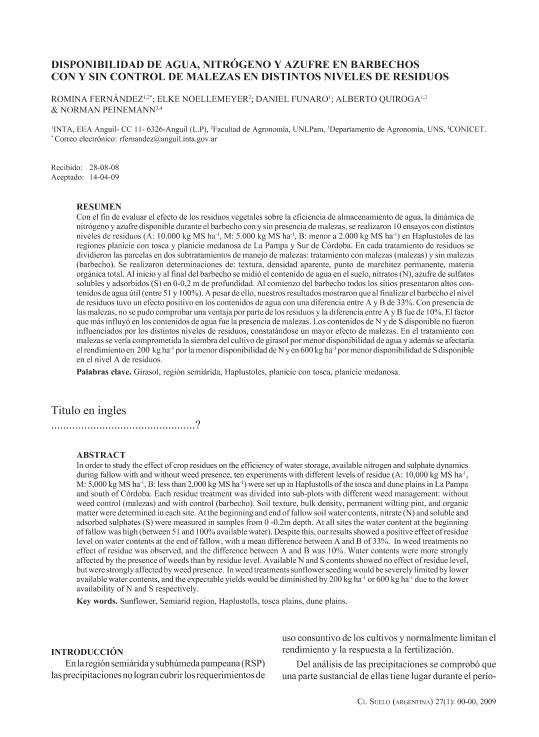Artículo
Con el fin de evaluar el efecto de los residuos vegetales sobre la eficiencia de almacenamiento de agua, la dinámica denitrógeno y azufre disponible durante el barbecho con y sin presencia de malezas, se realizaron 10 ensayos con distintosniveles de residuos (A: 10.000 kg MS ha-1, M: 5.000 kg MS ha-1, B: menor a 2.000 kg MS ha-1) en Haplustoles de lasregiones planicie con tosca y planicie medanosa de La Pampa y Sur de Córdoba. En cada tratamiento de residuos sedividieron las parcelas en dos subtratamientos de manejo de malezas: tratamiento con malezas (malezas) y sin malezas(barbecho). Se realizaron determinaciones de: textura, densidad aparente, punto de marchitez permanente, materiaorgánica total. Al inicio y al final del barbecho se midió el contenido de agua en el suelo, nitratos (N), azufre de sulfatossolubles y adsorbidos (S) en 0-0,2 m de profundidad. Al comienzo del barbecho todos los sitios presentaron altos con-tenidos de agua útil (entre 51 y 100%). A pesar de ello, nuestros resultados mostraron que al finalizar el barbecho el nivelde residuos tuvo un efecto positivo en los contenidos de agua con una diferencia entre A y B de 33%. Con presencia delas malezas, no se pudo comprobar una ventaja por parte de los residuos y la diferencia entre A y B fue de 10%. El factorque más influyó en los contenidos de agua fue la presencia de malezas. Los contenidos de N y de S disponible no fueroninfluenciados por los distintos niveles de residuos, constatándose un mayor efecto de malezas. En el tratamiento conmalezas se vería comprometida la siembra del cultivo de girasol por menor disponibilidad de agua y además se afectaríael rendimiento en 200 kg ha-1 por la menor disponibilidad de N y en 600 kg ha-1 por menor disponibilidad de S disponibleen el nivel A de residuos In order to study the effect of crop residues on the efficiency of water storage, available nitrogen and sulphate dynamicsduring fallow with and without weed presence, ten experiments with different levels of residue (A: 10,000 kg MS ha-1,M: 5,000 kg MS ha-1, B: less than 2,000 kg MS ha-1) were set up in Haplustolls of the tosca and dune plains in La Pampaand south of Córdoba. Each residue treatment was divided into sub-plots with different weed management: withoutweed control (malezas) and with control (barbecho). Soil texture, bulk density, permanent wilting pint, and organicmatter were determined in each site. At the beginning and end of fallow soil water contents, nitrate (N) and soluble andadsorbed sulphates (S) were measured in samples from 0 -0.2m depth. At all sites the water content at the beginningof fallow was high (between 51 and 100% available water). Despite this, our results showed a positive effect of residuelevel on water contents at the end of fallow, with a mean difference between A and B of 33%. In weed treatments noeffect of residue was observed, and the difference between A and B was 10%. Water contents were more stronglyaffected by the presence of weeds than by residue level. Available N and S contents showed no effect of residue level,but were strongly affected by weed presence. In weed treatments sunflower seeding would be severely limited by loweravailable water contents, and the expectable yields would be diminished by 200 kg ha-1 or 600 kg ha-1 due to the loweravailability of N and S respectively.
Disponibilidad de agua, nitrogeno y azufre en barbechos con y sin control de malezas en distintos niveles de residuos
Título:
Water, nitrogen and sulphur availability in fallows with and without weed control and different residue levels
Fernandez, Romina Daiana ; Noellemeyer, Elke Johanna; Funaro, Daniel; Quiroga, Alberto Raul; Peinemann, Norman
; Noellemeyer, Elke Johanna; Funaro, Daniel; Quiroga, Alberto Raul; Peinemann, Norman
 ; Noellemeyer, Elke Johanna; Funaro, Daniel; Quiroga, Alberto Raul; Peinemann, Norman
; Noellemeyer, Elke Johanna; Funaro, Daniel; Quiroga, Alberto Raul; Peinemann, Norman
Fecha de publicación:
06/2009
Editorial:
Asociación Argentina de la Ciencia del Suelo
Revista:
Ciencia del Suelo
ISSN:
0326-3169
e-ISSN:
1850-2067
Idioma:
Español
Tipo de recurso:
Artículo publicado
Clasificación temática:
Resumen
Palabras clave:
Girasol
,
Region Semiárida
,
Haplustoles
,
Planicie con Tosca
,
Planicie Medanosa
Archivos asociados
Licencia
Identificadores
Colecciones
Articulos(CCT - BAHIA BLANCA)
Articulos de CTRO.CIENTIFICO TECNOL.CONICET - BAHIA BLANCA
Articulos de CTRO.CIENTIFICO TECNOL.CONICET - BAHIA BLANCA
Citación
Fernandez, Romina Daiana; Noellemeyer, Elke Johanna; Funaro, Daniel; Quiroga, Alberto Raul; Peinemann, Norman; Disponibilidad de agua, nitrogeno y azufre en barbechos con y sin control de malezas en distintos niveles de residuos; Asociación Argentina de la Ciencia del Suelo; Ciencia del Suelo; 27; 1; 6-2009; 57-66
Compartir



